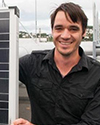DC Distribution for Puerto Rico – Planning Anew, Planning with Weather Effects in Mind
By Arif Ahmed, Daniel Burmester, Fiona Stevens Mcfadden and Ramesh Rayudu
As renewable power generation solidifies its position in the future power grid, the conventional approach to power distribution needs to adapt. A scenario, such as that of Puerto Rico, where the power system must be rebuilt, offers an opportunity for innovation and advanced technological applications in the premises of the smart grid.
Renewable energy sources and storage systems are, more often than not, direct current (DC) based, which has again focused attention on the war of the currents (DC vs alternating current, or AC). In a household with a renewable energy installation and storage, the power is transferred from DC to AC, and then in many appliances is converted back to DC internally. As each conversion reduces the efficiency of the system, it is advantageous to bypass the need for AC altogether. As a clear progression towards DC can be observed at a household level, it seems only logical to follow suit at a distribution level. However, one important consideration when discussing DC at a distribution level, which to date has not been standardised, is voltage level. Within the literature, there are five DC voltage levels that are regularly discussed, these are; 48V, 120V, 240V, 380V and 1200V. But what are the implications of each on the distribution lines and beyond?
To answer this question, we have explored the losses and thermal characteristics of the network supplying a small, partially photovoltaic power community, for each DC voltage level. Typically, such analysis has been performed with the traditional power flow algorithm. This, however, fails to take into account the dramatic effect weather plays on the distribution network, leading to a reduced accuracy in branch loss estimates, resistances, temperatures, and dynamic loading opportunities. The analysis we have performed for a case study in Puerto Rico uses a novel approach where the weather effects are coupled to the power flow algorithm via transient simulation, thus considering the previously neglected effects of weather on power networks.
The model (built in Matlab) used for this case study consists of ten households with varied load lines based on different residential loading scenarios. Overhead distribution lines feed the houses, which are 10m apart from each other connected by the 795 kcmil 26/7 Drake ACSR conductor. The cluster has a photovoltaic (PV) installation of 6kW located at the first household. The system, including the PV and distribution network is simulated under a week of Puerto Rico summer conditions, considering localized solar irradiance, ambient temperature, wind speed and wind angle.
The results of the simulations show that the lower voltages increase the thermal stress on the network due to the higher currents observed. At 48V and 120V, the temperature fluctuations are notably pronounced, indicating the possibility of premature aging of the distribution network. At the other end of the spectrum, 1200V, there is little thermal stressing at a distribution level. However, one must consider the operating voltages within a typical household, where many DC devices rely on very low voltages (e.g. 5V, 12V, 24V). Achieving a usable household voltage can become costly in both hardware and efficiency (as each voltage conversion will have associated losses) if such a high operating voltage of the distribution line is considered.
The results suggest that a DC distribution voltage should be in the range of 230V and 380V. This is where we observe little fluctuations in heat, the losses are manageable and the infrastructure required to interface households with the distribution network are minimal with ample amount of margin for sustaining higher load increase in future. This also creates a realistic connection voltage for rooftop solar installations to feed into the local distribution grid encouraging the uptake of a carbon neutral power source.
The advantages and disadvantages of a DC distribution network are broad and often difficult to quantify. The DC distribution network reduces the need for conversion between AC and DC, increasing the efficiency in renewable energy and storage systems. It is also single phase rather than three, reducing the infrastructure required to distribute power, a consideration when rebuilding a power system. Unlike AC power, DC has no reactive power issues associated with distribution, negating the need for reactive power management systems.
At a distribution and household level, one of the considerations must be protection and safety. As DC power does not have the zero crossing present in AC power, items such as breakers require additional design. The DC network will also make use of power electronics, which have the characteristic of aging at a faster rate than traditional network components, and also increases the complexity of the system. Another impeding factor, slowing down the transition from AC to DC, is the availability of DC household appliances. While this market is currently growing, as PV becomes increasingly popular, many devices are still inadequate or expensive. This then creates a scenario where the DC distribution network relies on DC appliances to progress, and vice versa.
So while a DC distribution network, ranging between 230V and 380V, brings challenges that need to be overcome, there are many advantages to such a network heading into the future of power systems.
This article was edited by Jose Medina.
Contributors

Arif Ahmed is currently pursuing a PhD and is also serving as the IEEE student branch chair at Victoria University of Wellington (VUW). He is also affiliated with the Smart Power and Renewable Energy Systems (SPRES) group and Robinson Research Institute (RRI) at VUW. His research focuses on advanced power system analysis by developing novel techniques that incorporate dynamic weather data into power system studies. His research interests include power system analysis, power system stability, power system control, and smart power systems.

Daniel Burmester holds a B.E. (First Class-Distinction) and a PhD in electronics and computer systems engineering both from Victoria University of Wellington (New Zealand). He is a cofounder of the Smart Power and Renewable Energy Systems (SPRES) group and is part of the sustainable energy systems group (VUW). Daniel currently lectures in the school of engineering and computer systems (Victoria University of Wellington), specialising in renewable energy systems engineering.

Fiona Stevens Mcfadden is currently part of the Robinson Research Institute (RRI) at VUW and is also affiliated with the Smart Power and Renewable Energy Systems (SPRES) group at VUW. Her 29-year industrially-focused R&D career spans the industrial, commercial, and academic sectors in both Australia and New Zealand. Her current research field is the application of predictive modelling and data analytics for decision-making, control, and optimisation for industry applications. Two current projects focus on improving the operation of the electricity distribution network and extending the life of the distribution infrastructure. She is working on another project focused on augmented perception for adaptive learning robots to complement the human workforce. Over her career she has received two best paper awards for her research and in 2013 one of her earliest research publications was republished in a compilation of papers recognized as the ‘most important findings and insights reported over the past five decades’ in aluminium smelting. She received a BE (1st class honours) in 1989 and an engineering PhD in the area of advanced process control in 2006, both from the University of Auckland (New Zealand)

Ramesh Rayudu has over 15 years of industrial work experience both in India and New Zealand. He is also involved in consultation work for several international firms in New Zealand, Australia, Singapore, Malaysia, India, and the USA. He is currently a senior lecturer at Victoria University of Wellington. His current research interests include power systems engineering, renewable energy systems, energy management, health monitoring, and energy harvesting. Ramesh has written over 100+ publications for journals, invited articles and papers for magazines and conferences, and has won three best paper and four best presentation awards. He was co-awarded the prestigious IPENZ 1999 Fulton Downer Silver Medal. He is active in IEEE activities and is currently treasurer of IEEE NZCS and the Chair of local PES Chapter. He was also the general co-chair for the 2017 IEEE Power & Energy Society Innovative Smart Grid Technologies Asia (ISGT Asia) conference, New Zealand. He holds a B.E. (First Class–Distinction) from Osmania University (India), a M.E. from University of Canterbury (NZ) and a PhD in AI and power systems engineering from Lincoln University (NZ).
To have the Bulletin delivered monthly to your inbox, join the IEEE Smart Grid Community.
Past Issues
To view archived articles, and issues, which deliver rich insight into the forces shaping the future of the smart grid. Older Bulletins (formerly eNewsletter) can be found here. To download full issues, visit the publications section of the IEEE Smart Grid Resource Center.




